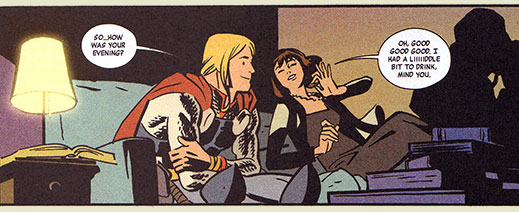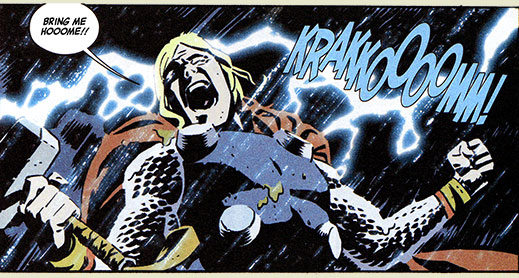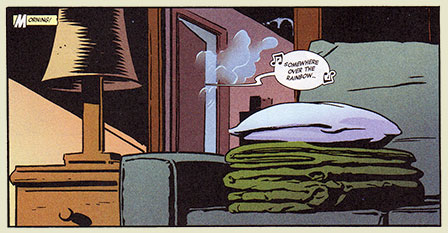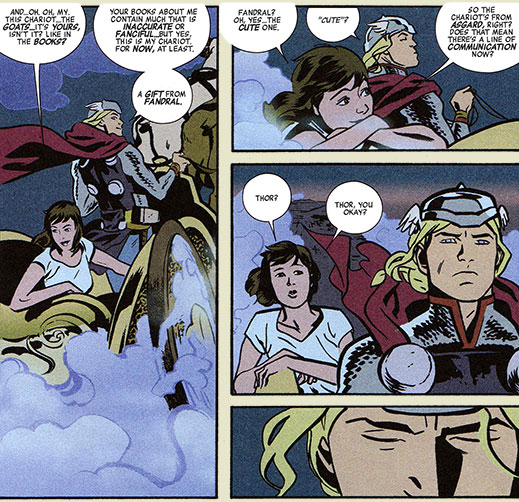Thor: The Mighty Avenger
Created by: Roger Langridge and Chris Samnee
Published by: PUBLISHER
ISBN: 0785141219 Amazon
Pages: 256




Thor, at least in the manner by which Marvel has defined him, is a character who probably shouldn't interest me. I grew up loving various non-American mythologies and found the cultures that produced them to be interesting. Greek, Roman, Japanese, Norse—oh how I loved the Norse mythologies. And the idea of that Norse mythos coming to life in contemporary North America sounds delectable in purely conceptual terms. It's just the loud, boisterously costumed Jack-Kirby Asgardians that I couldn't get behind, the Norse lords who spoke in a faux-Elizabethan pidgin and wouldn't kill humans for whatever reason. They were too sanitized to tempt me.*
This was the opinion that reigned in me until I encountered Walt Simonson's vision of the Asgardians when I was in high school. I still held many of my reservations, but the sheer bombasticism of Simonson's rendition was so dramatic, so intense, that I was won over for the space of his run on the book.** After Simonson finished his run, I too departed, unenthusiastic for the direction new creators might take. I grew skeptical that I could ever take Marvel's Thor seriously again. It took twenty years,*** but eventually I found another creative team who could make the thundering Asgardian a worthy diversion of my time. Unfortunately, Marvel cancelled the book after eight issues—a move that infuriates me as a reader who wants to read good books.

So what's so great about Langridge and Samnee's Thor: The Mighty Avenger? Honestly, nearly everything. I'm pretty well on record as not being any longer excited or too interested in superhero comics. Apart from rare exceptions, I simply avoid the books, not wanting to be disappointed by most of what I might read. This Thor, on the other hand, hits all the right notes for me. The story is engaging and charming. The art meets narrative and characters perfectly. And best of all, it left me wanting more.
Well, best of all if Marvel hadn't cancelled the book.
Apparently, and I hadn't had ear to the ground enough to know this 'til now, Thor: The Mighty Avenger is/was part of Marvel's more kid-friendly line. One can see the trailmarkers if one looks. A re-introduction of the character. Chapters that while accommodating a larger general arc are self-contained enough that readers could approach any one of them on their own and be relatively satisfied. The violence is clean and the more mature romantic instances are only hinted at—and in such a way that many adult readers might gloss over. The story is brisk, fun, humourous, romantic, sweet, and adventurous.
 Case study in subtlety:
Case study in subtlety:
This panel means that Thor and Jane engaged in nocturnal romantic relations.
Chris Samnee's art is wonderfully expressive. While much of the contemporary superheroic genre demands the highly detailed and too-realistic art styles we've seen in Bryan Hitch and Alex Maleev and Greg Land, each of those styles (for whatever benefits they might bring to their books) all suffer one substantial deficit: their inability to convey easily a range of emotions. (For example, for all Tony Harris' talent, it can be difficult to watch him struggle to portray a particular instance of emotion in practically every chapter of Ex Machina; Greg Land, on the other hand, seems limited to maybe three.) Samnee's work is more fluid, relying on some of the tricks and exaggerations that animators prefer. There is never a point at which the reader will be confused as to what Thor's or Jane's expressions mean. This is not something that can be said for the bulk of contemporary America's superhero books.
 I mean, look at this scene. It's gorgeous and hilarious.
I mean, look at this scene. It's gorgeous and hilarious.
And because this book may actually be more about relationships than it is about heroic deeds, Samnee's ability to convey winsome character interactions is essential to its success. Thor: The Mighty Adventure, if meant for the cinema instead of the comics form, would probably be one of those films that gets marketed as a summer blockbuster but is really much more successful because it appeals to more than just the testosterone fantasies of teenage boys. The building relationship between Thor and Jane is sensitive, believable, and actually pretty compelling. Probably lots of people would like it if they gave it a chance.
Honestly though, I think this would have perhaps appealed better had it not been a story about Marvel's Thor, a character with fifty years of history and expectations. The characters are solid and we like them, but they're built from the ground up out of new material. There's no necessary relation to the Marvel hero and the insinuation of Thor's old opponents (Mr. Hyde, Fin Fang Foom,**** etc.) feels tacked on—as if their inclusion comes only due to a marketing mandate. These are things that happen because this is a Thor comic, not because they ought to happen. The fact of the matter is that this didn't need to be a "Thor" comic at all. It didn't have to take place in the Marvel Universe (even one of their dusty, unused/unusable ones).

In fact, seeing how poorly Marvel supported the book, it almost certainly would have been better had Langridge and Samnee made this book wholly apart from the big publisher's bumbling. My gosh, even imagining what could have been had this creative team made their own book—one that happened to follow the story of a mythological god of thunder finding himself stuck on earth and meeting a nice girl? A book wholly of their own, investing the creators with the ability to compose it as they would, with beginning, middle, and end? Holy cats that would have been something.
Something to look forward to, I guess? A dream, a hope, something to believe in.
Notes
* To be fair, I wasn't exactly entranced by Neil Gaiman's expression of the Norse pantheon in American Gods, either.
** I'm curious how much of my abiding adoration for Simonson's work on the book is due to nostalgia's grasp upon my sense of things. I hope to read through Marvel's recent Simonson Omnibus soon to reacquaint myself with those old stories.
*** Technically, more, but I wasn't reading Simonson's Thor concurrent to its original publication save for an issue or two. I probably first read through Simonson's entire Thor arc around 1990 or so.
**** And I actually really enjoyed how they made Fin Fang Foom just a form that Heimdall took in order to confront Thor.
Good Ok Bad features reviews of comics, graphic novels, manga, et cetera using a rare and auspicious three-star rating system. Point systems are notoriously fiddly, so here it's been pared down to three simple possibilities:
3 Stars = Good
2 Stars = Ok
1 Star = Bad
I am Seth T. Hahne and these are my reviews.
Browse Reviews By
Other Features
- Best Books of the Year:
- Top 50 of 2024
- Top 50 of 2023
- Top 100 of 2020-22
- Top 75 of 2019
- Top 50 of 2018
- Top 75 of 2017
- Top 75 of 2016
- Top 75 of 2015
- Top 75 of 2014
- Top 35 of 2013
- Top 25 of 2012
- Top 10 of 2011
- Popular Sections:
- All-Time Top 500
- All the Boardgames I've Played
- All the Anime Series I've Seen
- All the Animated Films I've Seen
- Top 75 by Female Creators
- Kids Recommendations
- What I Read: A Reading Log
- Other Features:
- Bookclub Study Guides









